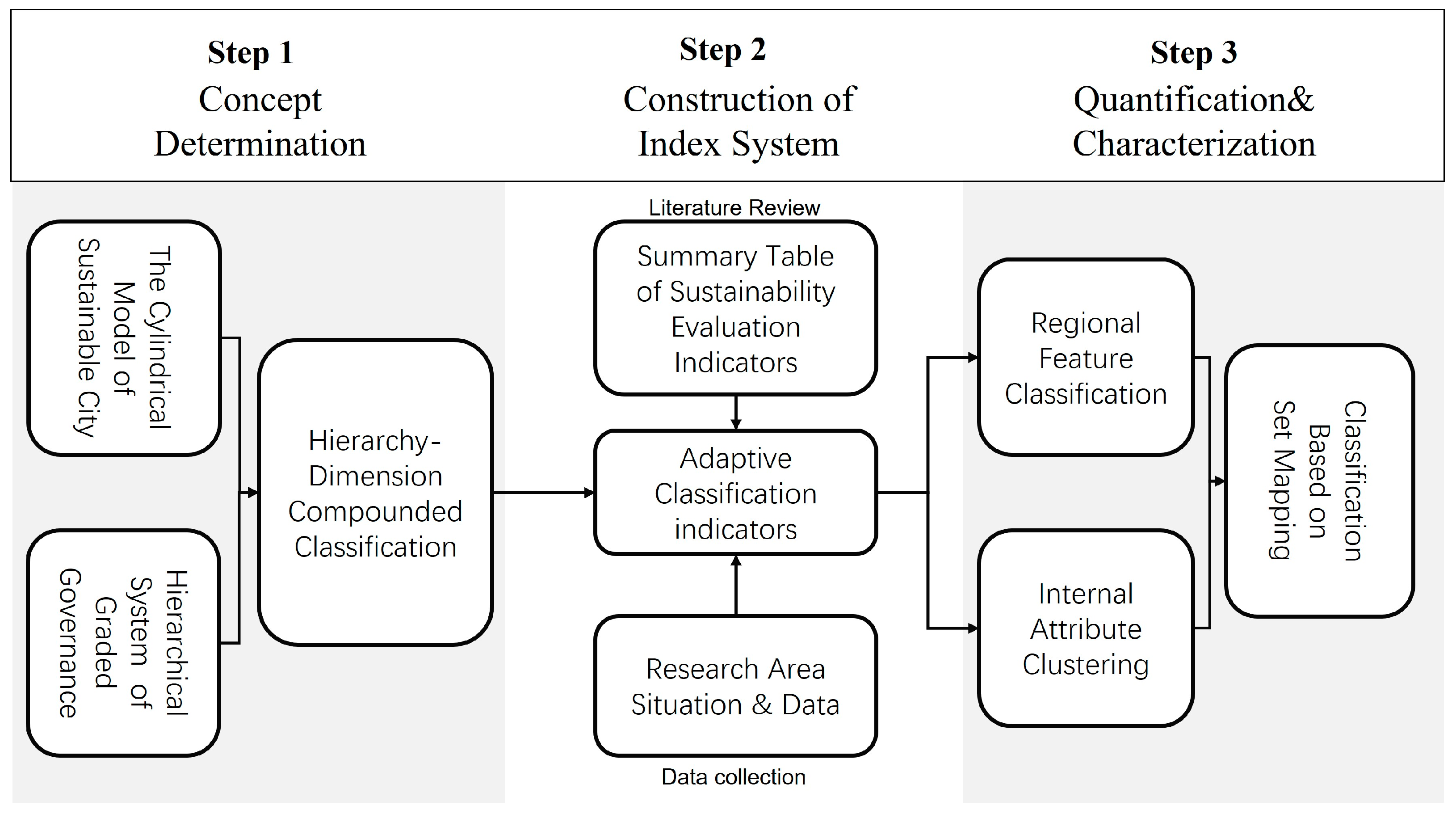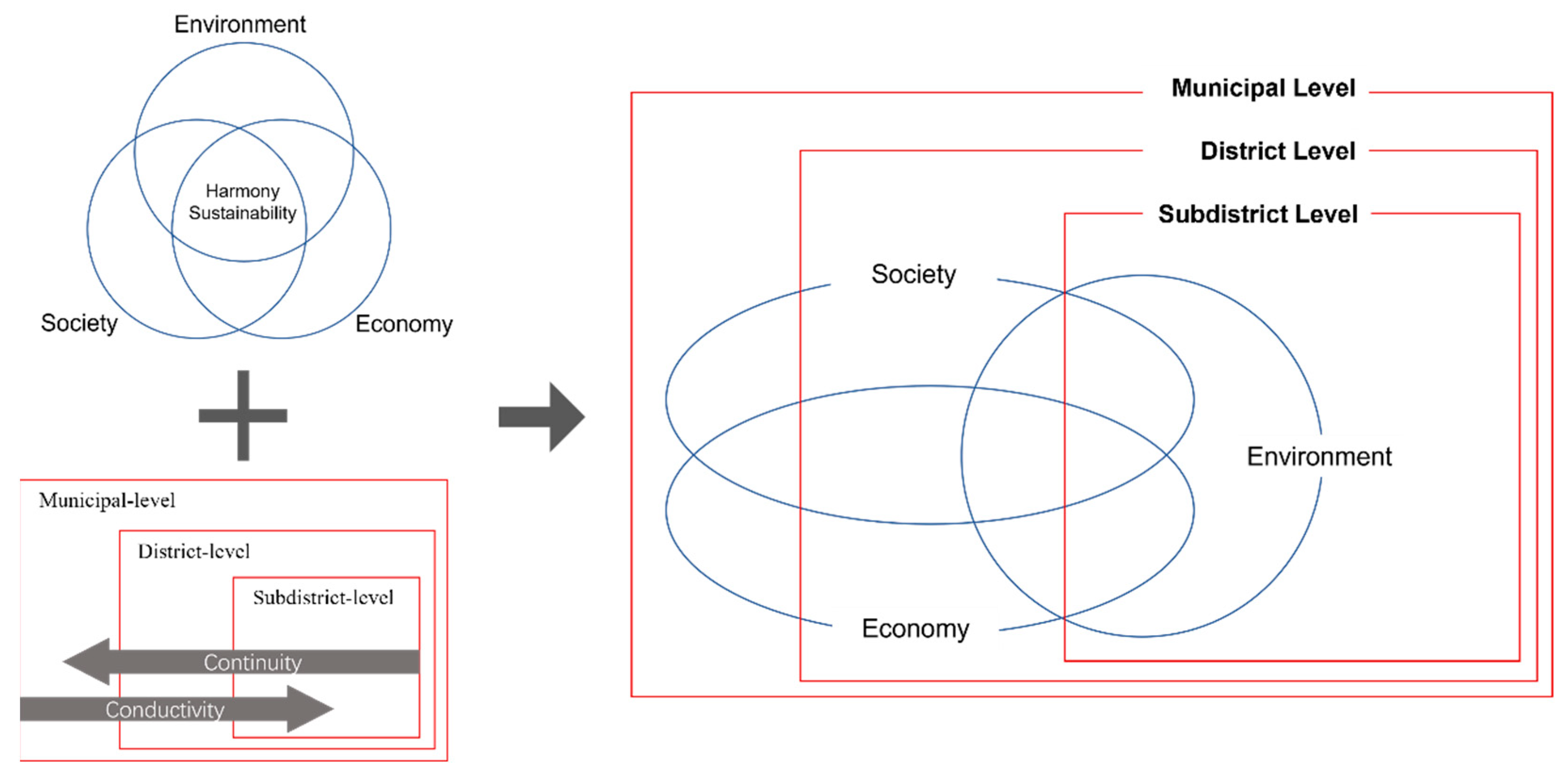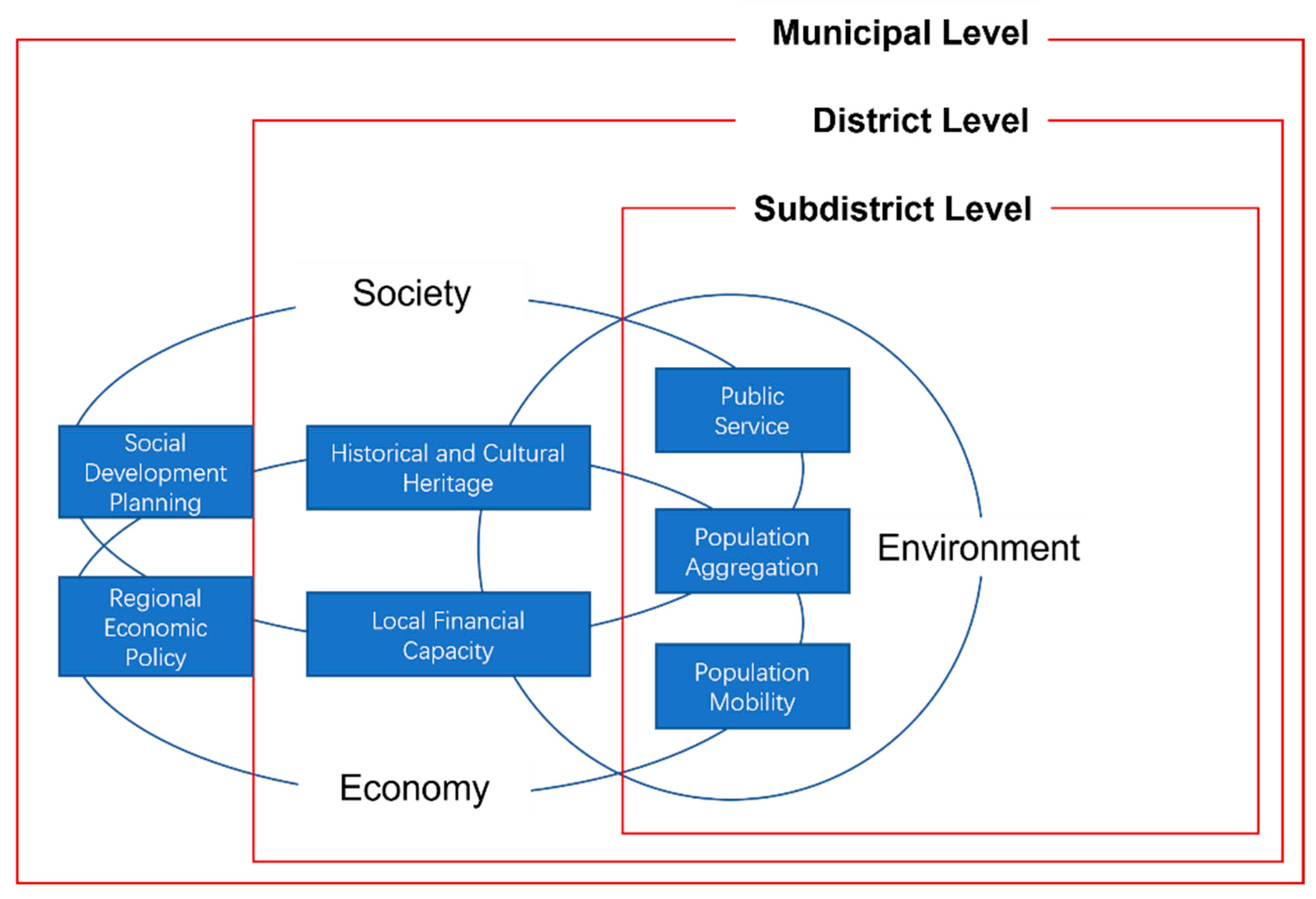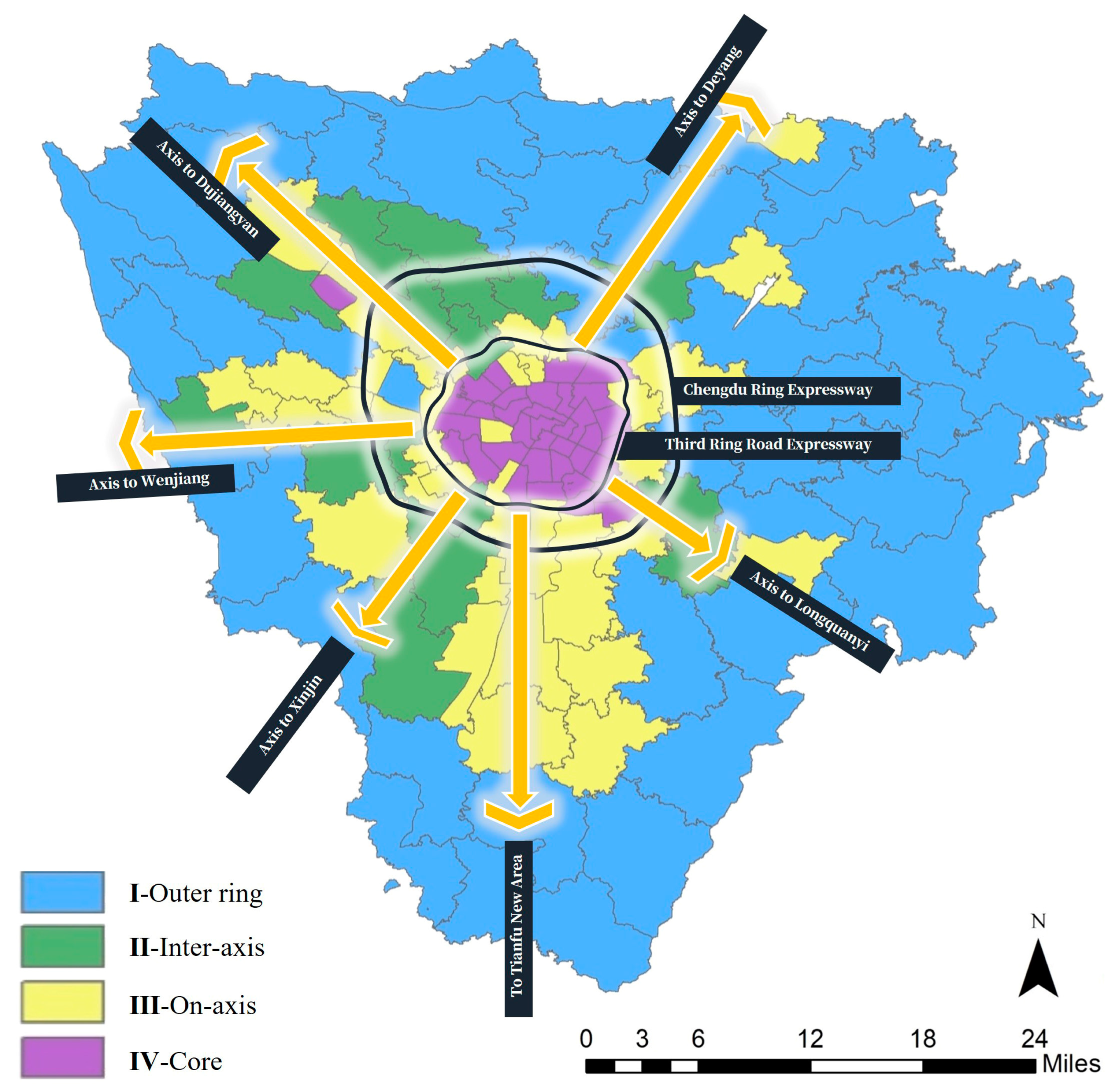Classification and Spatial Differentiation of Subdistrict Units for Sustainable Urban Renewal in Megacities: A Case Study of Chengdu
Abstract
1. Introduction
2. Materials and Methods
2.1. Study Area and Data Source
2.2. Classification Concept and Indicator System
2.3. Quantification and Characterization of Indicators
3. Results
3.1. Mismatch of Regional Features
3.2. Circular-Axial Spatial Pattern of Internal Characteristics
3.3. The Circular and Axial Structures Shape the Composite-Type Results
4. Discussion
4.1. An Emphasis on Participatory Governance in High-Density Central Areas
4.2. Consideration Should Be Given to Equity in Peri-Urban Areas
4.3. Research Significance and Prospects
5. Conclusions
Author Contributions
Funding
Data Availability Statement
Conflicts of Interest
References
- Wu, Z.Q.; Liu, Z.H. “Harmonious City”: A General Urban Planning Theory Model. Urban Plan. Forum 2014, 3, 12–19. [Google Scholar]
- Bouzguenda, I.; Alalouch, C.; Fava, N. Towards smart sustainable cities: A review of the role digital citizen participation could play in advancing social sustainability. Sustain. Cities Soc. 2019, 50, 101627. [Google Scholar] [CrossRef]
- Yang, J.Q. Basic Characteristics and Planning Suggestions for Urban Renewal in the New Development Stag. Governance 2021, 359, 17–22. [Google Scholar]
- Zheng, H.W.; Shen, G.Q.; Wang, H. A review of recent studies on sustainable urban renewal. Habitat Int. 2014, 41, 272–279. [Google Scholar] [CrossRef]
- Cao, K.X.; Deng, Y. Spatio-temporal evolution path and driving mechanisms of sustainable urban renewal: Progress and perspective. Prog. Geogr. 2021, 40, 1942–1955. [Google Scholar] [CrossRef]
- Ye, Z.J.; Lin, J. Review of Decision-making Support Methods of Sustainable Urban Renewal. Areal Res. Dev. 2020, 39, 59–64. [Google Scholar]
- Han, Z.M.; Liu, Z.Y. A New Era Approach towards Good Governance of Mega cities: Planning and Practice for the Transformation and Upgrading of Megacity Governance. Urban Probl. 2023, 4, 4–11. [Google Scholar]
- Ye, M. Separating Subdistricts: Strategies for Fine Governance of Suburban Suburbs in Mega cities. Theory J. 2021, 3, 108–115. [Google Scholar]
- Zhao, K.K.; Sun, W.H.; Li, X.Y. The Characteristics and Trends of Local Urban Renewal System in China: A Comparison of the Content of 20 Local Urban Renewal Regulations. Planners 2022, 38, 5–10. [Google Scholar]
- Gu, Y.; Li, Q.S.; Yin, W.N. Exploring the Urban Micro Renewal Path of Shiquan Road Street in Putuo District, Shanghai, with Community Streets as the Main Body. Urban Plan. Forum 2022, 274, 161–166. [Google Scholar]
- Cinelli, M.; Coles, S.R.; Kirwan, K. Analysis of the potentials of multi criteria decision analysis methods to conduct sustainability assessment. Ecol. Indic. 2014, 46, 138–148. [Google Scholar] [CrossRef]
- Peng, Y.; Lai, Y.; Li, X.; Zhang, X. An alternative model for measuring the sustainability of urban regeneration: The way forward. J. Clean. Prod. 2015, 109, 76–83. [Google Scholar] [CrossRef]
- Lee, J.H.; Lim, S. An Analytic Hierarchy Process (AHP) Approach for Sustainable Assessment of Economy-Based and Community-Based Urban Regeneration: The Case of South Korea. Sustainability 2018, 10, 4456. [Google Scholar]
- Awad, J.; Jung, C. Extracting the Planning Elements for Sustainable Urban Regeneration in Dubai with AHP. Sustain. Cities Soc. 2022, 76, 103496. [Google Scholar] [CrossRef]
- Kara, C.; Iranmanesh, A. Modelling and Assessing Sustainable Urban Regeneration for Historic Urban Quarters via Analytical Hierarchy Process. Land 2023, 12, 72. [Google Scholar] [CrossRef]
- Zheng, W.; Shen, G.Q.; Wang, H.; Hong, J.; Li, Z. Decision support for sustainable urban renewal: A multi-scale model. Land Use Policy 2017, 69, 361–371. [Google Scholar] [CrossRef]
- Phillis, Y.A.; Kouikoglou, V.S.; Verdugo, C. Urban sustainability assessment and ranking of cities. Comput. Environ. Urban Syst. 2017, 64, 254–265. [Google Scholar] [CrossRef]
- Wątróbski, J.; Bączkiewicz, A.; Ziemba, E.; Sałabun, W. Sustainable cities and communities assessment using the DARIA-TOPSIS method. Sustain. Cities Soc. 2022, 83, 103926. [Google Scholar] [CrossRef]
- Oppio, A.; Bottero, M.; Arcidiacono, A. Assessing urban quality: A proposal for a MCDA evaluation framework. Ann. Oper. Res. 2018, 312, 1444–1457. [Google Scholar] [CrossRef]
- Zhao, D.; Liu, J.; Sun, L.; Ye, B.; Hubacek, K.; Feng, K.; Varis, O. Quantifying economic-social-environmental trade-offs and synergies of water-supply constraints: An application to the capital region of China. Water Res. 2021, 195, 116986. [Google Scholar] [CrossRef]
- Li, W.; Yi, P. Assessment of city sustainability—Coupling coordinated development among economy, society and environment. J. Clean. Prod. 2020, 256, 120453. [Google Scholar] [CrossRef]
- Hou, D.; Al-Tabbaa, A.; O’Connor, D.; Hu, Q.; Zhu, Y.G.; Wang, L.; Kirkwood, N.; Ok, Y.S.; Tsang, D.C.; Bolan, N.S.; et al. Sustainable remediation and redevelopment of brownfield sites. Nat. Rev. Earth Environ. 2023, 4, 271–286. [Google Scholar] [CrossRef]
- Yang, C.; Xin, L.; Lan, B.; Xiao, G.; Zhao, W. The Community Perspective of Mega cities Governance-Thoughts on the Compilation of Chengdu Urban and Rural Community Development Planning 2018–2035. Urban Plan. Forum 2020, 255, 71–78. [Google Scholar]
- Yang, C. Local Lived Aesthetic System: An Old Town Renewal Model with Creative Life as the Core. Urban Plan. Int. 2023, 38, 65–73. [Google Scholar]
- He, X.W.; Lyu, F.; Wei, X.F. Research on the Renewal Strategy of Urban Old Community Based on Multi-Objective Cooperation. J. Hum. Settl. West China 2021, 36, 102–111. [Google Scholar]
- Zhu, S.Y.; Li, D.Z.; Jiang, Y. The impacts of relationships between critical barriers on sustainable old residential neighborhood renewal in China. Habitat Int. 2020, 103, 102232. [Google Scholar] [CrossRef]
- Liu, Q.Y.; Fan, J.F.; Chen, Z.; Li, B.; Han, L.S. Expansion analysis of Chengdu-Chongqing urban agglomeration under nighttime light remote sensing data consistency correction. Sci. Surv. Mapp. 2022, 47, 99–108. [Google Scholar]
- Ding, R.; Fu, J.; Zhang, Y.; Zhang, T.; Yin, J.; Du, Y.; Zhou, T.; Du, L. Research on the Evolution of the Economic Spatial Pattern of Urban Agglomeration and Its Influencing Factors, Evidence from the Chengdu-Chongqing Urban Agglomeration of China. Sustainability 2022, 14, 10969. [Google Scholar] [CrossRef]
- Schneider, A.; Chang, C.Y.; Paulsen, K. The changing spatial form of cities in Western China. Landsc. Urban Plan. 2015, 135, 40–61. [Google Scholar] [CrossRef]
- Zhou, Y.; Long, Y. Urban Development Analysis and Simulation to Address Inventory and Increment Planning: A Case Study of Chengdu. Geogr. Geo-Inf. Sci. 2016, 32, 45–51. [Google Scholar]
- Yang, Y.; Li, G.P.; Sun, Y.; Fu, H. Comparative Study on Urban Physical Examination and Planning Implementation Evaluation of Big Cities at Home and Abroad. Sci. Geogr. Sin. 2022, 42, 198–207. [Google Scholar]
- De Jong, M.; Joss, S.; Schraven, D.; Zhan, C.; Weijnen, M. Sustainable–smart–resilient–low carbon–eco–knowledge cities; making sense of a multitude of concepts promoting sustainable urbanization. J. Clean. Prod. 2015, 109, 25–38. [Google Scholar] [CrossRef]
- Xing, L.; Xue, M.; Hu, M. Dynamic simulation and assessment of the coupling coordination degree of the economy–resource–environment system: Case of Wuhan City in China. J. Environ. Manag. 2019, 230, 474–487. [Google Scholar] [CrossRef]
- Yang, W.A.N.G.; Hua, T.A.N.G.; Jin, P.A.N.; Yang, L.I.; Qiao, C.H.U.; Yuqing, L.I.U. Application of real estate big data in spatial evaluation model of urban renewal potential. Bull. Surv. Mapp. 2020, 525, 71–74+82. [Google Scholar]
- Ahvenniemi, H.; Huovila, A.; Pinto-Seppä, I.; Airaksinen, M. What are the differences between sustainable and smart cities? Cities 2017, 60, 234–245. [Google Scholar] [CrossRef]
- Fang, H.S.; Lu, W.J.; Su, Y.Q. Theory and Evidence on the Distribution of Fiscal Revenue between Governments below Provinces in China. Econ. Res. J. 2020, 55, 118–133. [Google Scholar]
- Tian, J.X.; Hao, J.; Shan, Y.M. Exploration on the Construction of Spatial Protection System of Urban Historical and Cultural Resources Under the Background of Territory Spatial Planning: A Case Study of Liaocheng City, Shandong Province. Urban Stud. 2022, 29, 60–65+81. [Google Scholar]
- He, Q.; He, W.; Song, Y.; Wu, J.; Yin, C.; Mou, Y. The impact of urban growth patterns on urban vitality in newly built-up areas based on an association rules analysis using geographical ‘big data’. Land Use Policy 2018, 78, 726–738. [Google Scholar] [CrossRef]
- Barbosa, H.; Barthelemy, M.; Ghoshal, G.; James, C.R.; Lenormand, M.; Louail, T.; Menezes, R.; Ramasco, J.J.; Simini, F.; Tomasini, M. Human mobility: Models and applications. Phys. Rep. 2018, 734, 1–74. [Google Scholar] [CrossRef]
- Wang, F.; Wei, X.; Liu, J.; He, L.; Gao, M. Impact of high-speed rail on population mobility and urbanization: A case study on Yangtze River Delta urban agglomeration, China. Transp. Res. Part A Policy Pract. 2019, 127, 99–114. [Google Scholar] [CrossRef]
- Cui, N.N.; Gu, H.Y.; Shen, T.Y. The spatial differentiation and relationship between housing prices and rents: Evidence from Beijing in China. Geogr. Res. 2019, 38, 1420–1434. [Google Scholar]
- Zeng, Z.W.; Li, Y.L.; Tang, H. Multidimensional Spatial Driving Factors of Urban Vitality Evolution at the Subdistrict Scale of Changsha City, China, Based on the Time Series of Human Activities. Buildings 2023, 13, 2448. [Google Scholar] [CrossRef]
- Liu, T.; Liu, J.J.; Tang, L. Spatially Heterogeneous Determinants of Residential Rent in Beijing. City Plan. Rev. 2023, 47, 75–84. [Google Scholar]
- Wang, Y.; Wu, K.M.; Zhang, H.O. The core influencing factors of housing rent difference in Guangzhou′s urban district. Acta Geogr. Sin. 2021, 76, 1924–1938. [Google Scholar]
- Peng, B.; Yang, Y.M. Problem and platform driven: Two paths for the sinking of the governance center of mega cities. Theory Reform 2023, 3, 79–93. [Google Scholar]
- Cao, L. Participatory governance in China: ‘Informal public participation’ through neighborhood mobilization. Environ. Plan. C Politics Space 2022, 40, 1693–1710. [Google Scholar] [CrossRef]
- Allard, S.W.; Pelletier, E. Volatility and Change in Suburban Nonprofit Safety Nets. RSF Russell Sage Found. J. Soc. Sci. 2023, 9, 134–160. [Google Scholar] [CrossRef]
- Levasseur, M.; Généreux, M.; Bruneau, J.F.; Vanasse, A.; Chabot, É.; Beaulac, C.; Bédard, M.M. Importance of proximity to resources, social support, transportation and neighborhood security for mobility and social participation in older adults: Results from a scoping study. BMC Public Health 2015, 15, 503. [Google Scholar] [CrossRef]
- Arnstein, S.R. A ladder of citizen participation. Am. Inst. Plan. 1969, 35, 216–224. [Google Scholar] [CrossRef]
- Hurlbert, M.; Gupta, J. The split ladder of participation: A diagnostic, strategic, and evaluation tool to assess when participation is necessary. Environ. Sci. Policy 2015, 50, 100–113. [Google Scholar] [CrossRef]
- He, X.S.; Hou, Q.Y. Resident Participation in Urban Communities: A Local Ladder Model. J. East China Norm. Univ. (Humanit. Soc. Sci.) 2019, 51, 33–42+236. [Google Scholar]
- Zhang, C.; Li, X.Y. The Trend of Multidimensional and Multiscale TOD Theory and Its Application in Developing Countries. Urban Plan. Int. 2023. [Google Scholar] [CrossRef]
- El-Geneidy, A.; Levinson, D.; Diab, E.; Boisjoly, G.; Verbich, D.; Loong, C. The cost of equity: Assessing transit accessibility and social disparity using total travel cost. Transp. Res. Part A Policy Pract. 2016, 91, 302–316. [Google Scholar] [CrossRef]
- Rashid, M. On Spatial Mechanisms of Social Equity: Exploring the Associations between Street Networks, Urban Compactness, and Social Equity. Urban Sci. 2022, 6, 52. [Google Scholar] [CrossRef]
- Monzón, A.; Ortega, E.; López, E. Efficiency and spatial equity impacts of high-speed rail extensions in urban areas. Cities 2013, 30, 18–30. [Google Scholar] [CrossRef]










| Hierarchy | Dimension | Keyword | Measurement | Source | Corresponding Indicators |
|---|---|---|---|---|---|
| Municipal | Economy Society | Policy | National and provincial preferential policies | CAO, K.X.; DENG, Y. 2021 [5] KARA, C.; IRANMANESH, A. 2023 [15] LEE, J.H.; LIM, S. 2018 [13] AWAD, J.; JUNG, C. 2022 [14] | Regional Economic Policies |
| GDP | GDP | CAO, K.X.; DENG, Y. 2021 [5] | |||
| Superior Planning | Priority Zoning | CAO, K.X.; DENG, Y. 2021 [5] KARA, C.; IRANMANESH, A. 2023 [15] | Social Development Planning | ||
| District | Economy Society | Landscape | Guidelines for construction style | WANG, Y.; TANG, H. et al., 2020 [34] YANG, C.; XIN, L. et al., 2020 [23] | Historical and Cultural Heritage Reservation |
| Regional Transport | Rail transit station density and line length | WANG, Y.; TANG, H. et al., 2020 [34] AWAD, J.; JUNG, C. 2022 [14] | Average Residential Rent | ||
| Fiscal Capacity | General public budget | CAO, K.X.; DENG, Y. 2021 [5] | General Public Budget Income | ||
| Industry | Industrial income Job provision | PENG, Y.; LAI, Y.N. et al., 2015 [12] CAO, K.X.; DENG, Y. 2021 [5] | |||
| Subdistrict District | Environment | Building Condition | Age, Ownership, Usage | PENG, Y.; LAI, Y.N. et al., 2015 [12] WANG, Y.; TANG, H. et al., 2020 [34] | Average Residential Rent Population Density |
| Surrounding | LCZ type, Greening rate | PENG, Y.; LAI, Y.N. et al., 2015 [12] WANG, Y.; TANG, H. et al., 2020 [34] AWAD, J.; JUNG, C. 2022 [14] | |||
| Quantity of Existence | Built-up Area Floor space | YANG, C.; XIN, L. et al., 2020 [23] CAO, K.X.; DENG, Y. 2021 [5] | |||
| Society | Affordability of Housing | Average rent and price | PENG, Y.; LAI, Y.N. et al., 2015 [12] LEE, J.H.; LIM, S. 2018 [13] WANG, Y.; TANG, H. et al., 2020 [34] | ||
| Culture | Heritage protection Local customs | PENG, Y.; LAI, Y.N. et al., 2015 [12] YANG, C.; XIN, L. et al., 2020 [23] KARA, C.; IRANMANESH, A. 2023 [15] | Historical and Cultural Heritage Reservation | ||
| Public Service | Education coverage Health service coverage Safety | PENG, Y.; LAI, Y.N. et al., 2015 [12] LEE, J.H.; LIM, S. 2018 [13] YANG, C.; XIN, L. et al., 2020 [23] KARA, C.; IRANMANESH, A. 2023 [15] | Average Residential Rent The Ratio of Permanent Population to Registered Residence Population | ||
| Economy | Local Commerce | Employment density, Convenient business service | PENG, Y.; LAI, Y.N. et al., 2015 [12] LEE, J.H.; LIM, S. 2018 [13] CAO, K.X.; DENG, Y. 2021 [5] AWAD, J.; JUNG, C. 2022 [14] | ||
| Land Use | Development intensity Functional blending | PENG, Y.; LAI, Y.N. et al., 2015 [12] WANG, Y.; TANG, H. et al., 2020 [34] AWAD, J.; JUNG, C. 2022 [14] |
| Assignment Value | Meanings of Value | |||
|---|---|---|---|---|
| Social Development Planning | Regional Economic Policies | Historical and Cultural Reservation | General Public Budget Income | |
| 0 | Ng. | Ng. | ||
| 1 | South and east expansion area Growth-oriented | With provincial development zone policies No national policies | With provincial reservation policies No national policies | Low |
| 2 | West and north Renovation area Growth-controlled | With national development and urbanization zone policies | With national reservation zones or other relics protection policies | Average |
| 3 | Central Comprehensive improvement and transformation | High | ||
| Type Code | Abbreviation | Count | Percentage |
|---|---|---|---|
| IV—core-R | CR | 34 | 26.6% |
| III—axis-R | AR | 2 | 1.6% |
| III—axis-Ag | AA | 12 | 9.4% |
| III—axis-C | AC | 20 | 15.6% |
| III—axis-Lf | AL | 5 | 3.9% |
| II—inter-axis-Lf | IA | 14 | 10.9% |
| I—outer ring-Wb | OW | 4 | 3.1% |
| I—outer ring-Ag | OA | 12 | 9.4% |
| I—outer ring-Lf | OL | 25 | 19.5% |
Disclaimer/Publisher’s Note: The statements, opinions and data contained in all publications are solely those of the individual author(s) and contributor(s) and not of MDPI and/or the editor(s). MDPI and/or the editor(s) disclaim responsibility for any injury to people or property resulting from any ideas, methods, instructions or products referred to in the content. |
© 2024 by the authors. Licensee MDPI, Basel, Switzerland. This article is an open access article distributed under the terms and conditions of the Creative Commons Attribution (CC BY) license (https://creativecommons.org/licenses/by/4.0/).
Share and Cite
Zuo, J.; Fan, J.; Huang, X.; Li, C.; Luo, J. Classification and Spatial Differentiation of Subdistrict Units for Sustainable Urban Renewal in Megacities: A Case Study of Chengdu. Land 2024, 13, 164. https://doi.org/10.3390/land13020164
Zuo J, Fan J, Huang X, Li C, Luo J. Classification and Spatial Differentiation of Subdistrict Units for Sustainable Urban Renewal in Megacities: A Case Study of Chengdu. Land. 2024; 13(2):164. https://doi.org/10.3390/land13020164
Chicago/Turabian StyleZuo, Jin, Jiahui Fan, Xingyu Huang, Chen Li, and Jiancheng Luo. 2024. "Classification and Spatial Differentiation of Subdistrict Units for Sustainable Urban Renewal in Megacities: A Case Study of Chengdu" Land 13, no. 2: 164. https://doi.org/10.3390/land13020164
APA StyleZuo, J., Fan, J., Huang, X., Li, C., & Luo, J. (2024). Classification and Spatial Differentiation of Subdistrict Units for Sustainable Urban Renewal in Megacities: A Case Study of Chengdu. Land, 13(2), 164. https://doi.org/10.3390/land13020164






